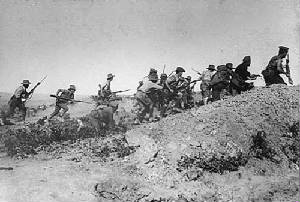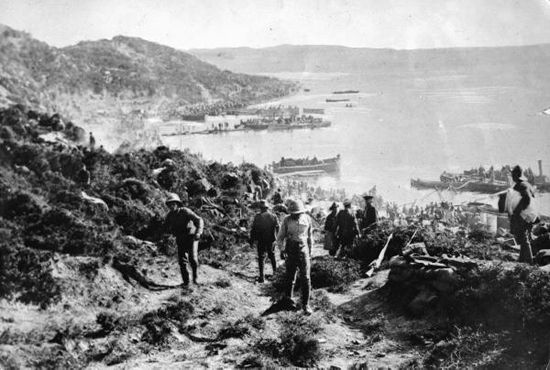|
1915 - Gallipoli
Battle for Gallipoli: February 1915 - January 1916

By 1915 the Western Front was clearly deadlocked. Allied strategy
was under scrutiny, with strong arguments mounted for an offensive through the Balkans or even a landing on Germany's Baltic
coast, instead of more costly attacks in France and Belgium.
These ideas were initially sidelined, but in early 1915 the
Russians found themselves threatened by the Turks in the Caucasus and appealed for some relief. The British decided to mount
a naval expedition to bombard and take the Gallipoli Peninsula on the western shore of the Dardanelles, with Constantinople
as its objective. By capturing Constantinople, the British hoped to link up with the Russians, knock Turkey out of the war
and possibly persuade the Balkan states to join the Allies.
The naval attack began on 19 February. Bad weather caused delays
and the attack was abandoned after three battleships had been sunk and three others damaged. Military assistance was required,
but by the time troops began to land on 25 April, the Turks had had ample time to prepare adequate fortifications and the
defending armies were now six times larger than when the campaign began.
Against determined opposition, Australian and
New Zealand troops won a bridgehead at 'Anzac Cove' on the Aegean side of the peninsula. The British, meanwhile, tried to
land at five points around Cape Helles, but established footholds in only three before asking for reinforcements. Thereafter
little progress was made, and the Turks took advantage of the British halt to bring as many troops as possible onto the peninsula.
This
standstill led to a political crisis in London between Churchill, the First Lord of the Admiralty and the operation's chief
advocate, and Lord Fisher, the First Sea Lord, who had always expressed doubts about it. Fisher demanded that the operation
be discontinued and resigned when overruled. The Liberal government was replaced by a coalition and Churchill, though relieved
of his former post, remained in the War Council.
Amid sweltering and disease-ridden conditions, the deadlock dragged on
into the summer. In July the British reinforced the bridgehead at Anzac Cove and in early August landed more troops at Suvla
Bay further to the north, to seize the Sari Bair heights and cut Turkish communications. The offensive and the landings both
proved ineffectual within days, faced with waves of costly counter-attacks.
The War Council remained divided until late
1915 when it was decided to end the campaign. Troops were evacuated in December 1915 and January 1916. Had Gallipoli succeeded,
it could have ended Turkey's participation in the war. As it was, the Turks lost some 300,000 men and the Allies around 214,000,
achieving only the diversion of Turkish forces from the Russians. Bad leadership, planning and luck, combined with a shortage
of shells and inadequate equipment, condemned the Allies to seek a conclusion in the bloody battles of the Western Front.
Furthermore, Gallipoli's very public failure contributed to Asquith's replacement as Prime Minister by David Lloyd George
in December 1916.

|
| New Zealand and Australian soldiers landing at Anzac Cove, 25 April 1915. |
|
 |
|
 |
 |
|
|
|
Primer to events in Gallipoli
Opened 19 Feb. 1915
Opened 25 April 1915
Opened 28 April 1915
Opened 1 May 1915
Opened 6 May 1915
Opened 19 May 1915
Opened 4 June 1915
Opened 28 June 1915
Opened 12 July 1915
Opened 6 August 1915
Opened 6 August 1915
Opened 6 August 1915
Opened 6 August 1915
Opened 21 August 1915
Opened 21 August 1915
Opened 18 December 1915
|
|
 |
 |
|
 |
 |
 |
|
|
 |
 |
 |
|
|
|

